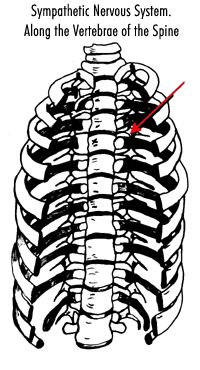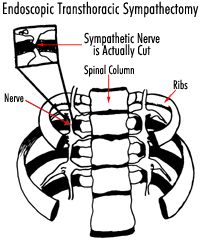What is Hyperhidrosis?
Sweating is the body’s natural mechanism of releasing excessive heat and cooling the body. However, in about one percent of the population, parts of the body (such as the hands, feet, face, and armpits) sweat profusely. This condition of excessive sweating, known as hyperhidrosis, is often brought on by stress and may be inherited.

Excessive sweating is primarily a cosmetic problem, but it can cause professional and social embarrassment, especially for those who work with their hands and experience overly sweaty palms. Some patients may experience facial blushing in addition to or instead of excessive sweating. Hyperhidrosis can also contribute to the development of other skin conditions, including infections.
The body’s sympathetic nervous system controls sweating. When this automatic, involuntary system does not function properly, the body may produce more perspiration than necessary to cool itself. An overactive sympathetic nervous system can be treated through surgery. Two types of glands produce sweat: eccrine glands and apocrine glands. The portion of the sympathetic nervous system that controls these glands is called the thoracic sympathetic ganglion chain, which runs along the vertebra of the spine inside the chest cavity. These are the glands affected by surgical treatments for hyperhidrosis.
Surgical Treatments
Since nonsurgical treatments of hyperhidrosis have only limited success, surgery is the only true cure for this condition. The surgical treatment for hyperhidrosis is a procedure called Endoscopic Thoracic Sympathectomy, sometimes called ETS. The procedure has about a 98% success rate in curing cases of overly sweaty palms, although the same procedure will treat hyperhidrosis in all areas of the body.
Simply put, the sympathectomy procedure severs, or interrupts, the nerves connected to the affected sweat glands. The procedure is performed through small incisions in the underarm area. The surgeon then locates and operates on the sympathetic nerves, located in the chest. This minimally invasive approach allows for relatively quick healing and recovery time. Recent advancements in imaging and instruments have also improved the precision of the procedure.
What Takes Place During Surgery?

The procedure itself takes about one hour. Once the patient is given general anesthesia, a small incision is made on the side of the body in the underarm area. The surgeon then inserts a small camera into the chest cavity; monitors allow the surgeon to view inside the patient and to carefully guide the instruments through the chest to the sympathetic chain. Depending on the symptoms to be treated, the T2, T3, and/or T4 spinal cord levels may be treated. The surgeon then removes a segment of the sympathetic nerve. The instruments are removed and the incision is closed. The procedure is then repeated on the other side of the body. Once the entire procedure is completed, the patient is transferred to the recovery room for about two hours. A chest x-ray may be performed to make sure that no air or blood is trapped within the chest cavity.
Following Surgery
The sympathectomy procedure is usually quite short. Most patients can return to normal activities within a few days. Compensatory sweating (when other parts of the body sweat more than they normally would) is the most common side effect of the surgery, although this is usually deemed preferable to the original hyperhidrosis. After surgery to curtail hyperhidrosis, many patients also regain their confidence in socializing, shaking hands, and public speaking.
Insurance Prerequisites
Insurance companies consider this procedure to be cosmetic. Many have outlined prerequisites to follow and fulfill before they will consider this procedure “medically necessary” and eligible for coverage. For a list of prerequisites, please contact your insurance company.
Once a patient meets all prerequisites outlined by their provider, prior authorization must be obtained from your insurance company by CTVS in order for the procedure to be covered. CTVS will submit medical records to the patient’s insurance company in order to deem the procedure “medically necessary”. The medical review of patient records takes anywhere from 45-60 days, at which point the patient will receive a letter from their provider with a decision on coverage. Patients can contact their insurance company at any time for status updates.

